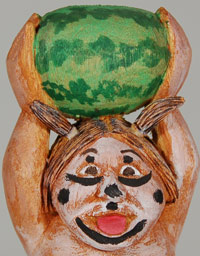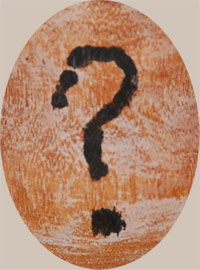Hopi-Tewa Koshari Clown with Watermelon [SOLD]
+ Add to my watchlist Forward to Friend
- Category: Traditional
- Origin: Hopi Pueblo, Hopituh Shi-nu-mu
- Medium: cottonwood, paint
- Size: 7-3/8” tall
- Item # C3383L SOLD
 The Koshari clowns arrived at Hopi with the arrival of the Tewa Indians from New Mexico who moved to the Hopi reservation following the Pueblo Revolt and they were given a village atop the First Mesa which is known as Hano Village. They live there today, still speak the Tewa language but have also adopted the Hopi language.
The Koshari clowns arrived at Hopi with the arrival of the Tewa Indians from New Mexico who moved to the Hopi reservation following the Pueblo Revolt and they were given a village atop the First Mesa which is known as Hano Village. They live there today, still speak the Tewa language but have also adopted the Hopi language.
The Tewa Pueblos of New Mexico—San Ildefonso, Tesuque, Ohkay Owingeh, Santa Clara, Nambe, and Pojoaque—use the name Koosa for these clowns. The Koosa is a name that incorporates the Kwirena, or Winter Clown and Koshari, or Summer Clown. At Hopi, they are generally referred to by the Hopi as Hano Clowns. They have existed for so long at First Mesa that they have now been adopted by other villages and may be seen at all the Hopi Villages and have become accepted as Hopi clowns.
 In this carving by Neil David, Sr. the clown is holding a watermelon atop his head as if he is in the process of throwing it to the ground and destroying it, a game often seen by the clowns. On the back of the clown is written BOSS in black paint and there is a clown doll tied on his rear with the belt that holds his loin cloth. The doll represents the clown’s “sister.” On the front is a big ? on his chest. As usual, the clown is shown with a large stomach, a sign of his gluttony.
In this carving by Neil David, Sr. the clown is holding a watermelon atop his head as if he is in the process of throwing it to the ground and destroying it, a game often seen by the clowns. On the back of the clown is written BOSS in black paint and there is a clown doll tied on his rear with the belt that holds his loin cloth. The doll represents the clown’s “sister.” On the front is a big ? on his chest. As usual, the clown is shown with a large stomach, a sign of his gluttony.
Neil David is an internationally known artist, admired for his drawings, paintings and katsina doll carvings. He was a founding member and full-time member of The Artist Hopid, a group of Hopi artists who exhibited their works together. He is an exceptional artist of paintings and carvings. His clowns are favorites of many collectors. Neil has a wonderful sense of humor and is able to express such in his carvings. The expression on the face of this clown is indicative of his being up to no good.
Condition: original condition
Provenance: from the estate of Tom Mittler, a former resident of Michigan and Santa Fe who purchased in from The Kiva in Taos in 1986
Recommended Reading: Hopi Katsina: 1,600 Artist Biographies by Gregory Schaaf
- Category: Traditional
- Origin: Hopi Pueblo, Hopituh Shi-nu-mu
- Medium: cottonwood, paint
- Size: 7-3/8” tall
- Item # C3383L SOLD



